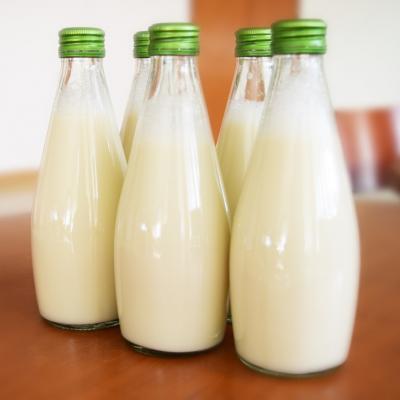Remember the days when the milkman delivered farm fresh milk to your doorstep? Weekly deliveries provided families with the goodness of wholesome dairy products. Milk has always been an essential part of the all American diet. Milk is one of the most nutritious drinks in the world and packed with a number of necessary vitamins and minerals that contribute to a healthy mind and body. In addition to high-quality protein, milk contains calcium, potassium, vitamin D, and Vitamin B12 which all help to grow strong bones and muscles; everyone from infants to adults of any age can benefit from the nutrients found in fresh dairy products.
Milk (dairy) comes in several varieties. The primary types of milk sold in stores are: whole milk, reduced-fat milk (2%), low-fat milk (1%), and fat-free milk. The percentages indicate how much fat is in the milk by weight. The nutrients in each type of milk remain the same though, only the taste and fat content is altered. For instance, if you like your milk creamy, but not too rich then a low-fat milk variety would be a good choice. If you’re counting calories you want fat-free milk.
Milk (dairy) comes in several varieties. The primary types of milk sold in stores are: whole milk, reduced-fat milk (2%), low-fat milk (1%), and fat-free milk. The percentages indicate how much fat is in the milk by weight. The nutrients in each type of milk remain the same though, only the taste and fat content is altered. For instance, if you like your milk creamy, but not too rich then a low-fat milk variety would be a good choice. If you’re counting calories you want fat-free milk.
The other factor that has an impact on taste, and some believe the nutritional value, is how milk is processed. The milk purchased in most grocery stores is pasteurized. Pasteurization is a specialized heating process that kills off harmful bacteria sometimes found in raw food and drinks. Its primary purpose is for product preservation and food safety. Pasteurization was instituted as a general practice by the US government in the early 19th century, prior to that people consumed raw milk for thousands of years. Today, pasteurization aids in keeping milk shelf safe when packaged and shipped many miles to storefronts. Most people are familiar with the taste of pasteurized milk, but there recently has been a surge in the raw milk movement. Unlike pasteurization, raw milk is unprocessed and consumed in its natural state, just as it is when milked directly from the cow. Many people adhere to the belief that this variety of unprocessed milk maintains a higher nutritional value by keeping alive good bacteria that is killed off during the high-heat pasteurization process. Europeans have enjoyed raw milk for centuries and it is still commonly consumed there today, as it is in many countries outside of the United States.
A Campaign for Real Milk, an advocacy group associated with the Weston A. Price Foundation and Farm to Consumer Legal Defense Fund believes that raw milk offers more health benefits to consumers and states that raw milk:
- Protects against infections, diarrhea, rickets, scurvy, tooth decay and tuberculosis
- Demonstrates better child growth profiles with longer and denser bones
- Improves vitamin A, B6 and D absorption
- Enhances mineral assimilation through the presence of lactobacilli
- Individuals diagnosed with lactose intolerance are often able to consume raw milk products without issue
An important consideration in choosing raw over pasteurized is to know where your milk product comes from and the conditions under which it is packaged and presented to the consumer. Any raw food product, including milk, should be as fresh as possible. This means look for reputable, local farms when purchasing raw food products. The closer to our food source we remain the fresher the product is likely to be. For instance, farm vendors that carry the Animal Welfare Approved seal indicate that the product comes from a farm that follows the highest standard of animal welfare and environmental standards. Don’t be afraid to ask questions about how and where food products are farmed and distributed. Know your food!
Did you know that, according to the US Department of Agriculture, 98% of America’s dairy farms are family owned and operated?!
Did you know that, according to the US Department of Agriculture, 98% of America’s dairy farms are family owned and operated?!
Some other fun facts about milk (source: USDA):
Milk remains an American food staple with generations enjoying the refreshing, fortified taste of this common, but classic beverage. Milk is also used regularly in American-style cooking and compliments both sweet and savory dishes. Below is a vintage recipe for old-fashioned Hot Milk Cake that many of your grandmothers may have baked, and you can still enjoy with new generations of milk lovers.
- The average American consumes roughly 20 gallons of milk per year.
- Move over Gatorade! Milk is the best recovery drink after a workout or other physical activity. The combination of carbohydrates, fat, protein, and other micronutrients makes milk the premier drink after physical excursion.
- US cows produce an average of 6 ½ gallons of milk per day per cow.
- Milk is sometimes called nature’s most nearly perfect food
- Milk is used to produce dairy products like cheese, yogurt, butter, and ice cream to dry or condensed milk and whey products.
- Cow’s milk was first drunk by humans 10,000 years ago in what is now Afghanistan and Iran.
Milk remains an American food staple with generations enjoying the refreshing, fortified taste of this common, but classic beverage. Milk is also used regularly in American-style cooking and compliments both sweet and savory dishes. Below is a vintage recipe for old-fashioned Hot Milk Cake that many of your grandmothers may have baked, and you can still enjoy with new generations of milk lovers.
Grandma’s Hot Milk Cake
This simple and delicious cake gets its distinctive flavor from the scalded milk in the batter
Ingredients:
1. In a large bowl, beat eggs on high speed for 5 minutes or until thick and lemon-colored. Gradually add sugar, beating until mixture is light and fluffy. Beat in vanilla. Combine flour and baking powder; gradually add to batter; beat at low speed until smooth.
2. In a small saucepan, heat milk and butter just until butter is melted. Gradually add to batter; beat just until combined.
3. Pour into a greased 13-in. x 9-in. baking pan. Bake at 350° for 30-35 minutes or until a toothpick inserted near the center comes out clean. Cool on a wire rack.
4. When cake is cool, dust with powdered sugar or cover with vanilla glaze
Yield: 12-16 servings
This simple and delicious cake gets its distinctive flavor from the scalded milk in the batter
Ingredients:
- 4 eggs
- 2 cups of sugar
- 1 teaspoon vanilla extract
- 2-1/4 cups of all-purpose flour
- 2-1/4 teaspoons of baking powder
- 1-1/4 cups of 2% milk
- 10 tablespoons butter, cubed
1. In a large bowl, beat eggs on high speed for 5 minutes or until thick and lemon-colored. Gradually add sugar, beating until mixture is light and fluffy. Beat in vanilla. Combine flour and baking powder; gradually add to batter; beat at low speed until smooth.
2. In a small saucepan, heat milk and butter just until butter is melted. Gradually add to batter; beat just until combined.
3. Pour into a greased 13-in. x 9-in. baking pan. Bake at 350° for 30-35 minutes or until a toothpick inserted near the center comes out clean. Cool on a wire rack.
4. When cake is cool, dust with powdered sugar or cover with vanilla glaze
Yield: 12-16 servings











